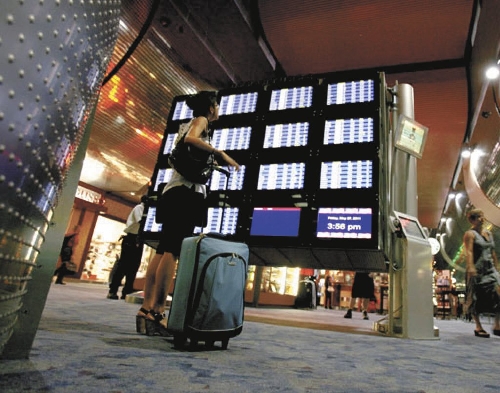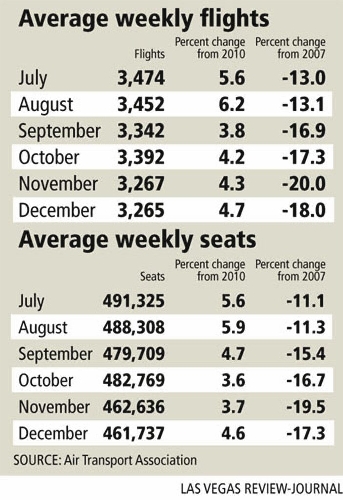Weekly flight counts set to increase at McCarran



The rebuilding of airline schedules at McCarran International Airport will gain momentum in the second half of this year with the weekly flight counts projected to run close to 5 percent ahead of last year.
This follows a first half in which schedules rose about 2 percent after three years of almost nonstop shrinkage. As a result, passenger counts finally broke the long downward march in January and have risen 2.9 percent in the four months through April.
Still, flight and seat counts compiled by the Air Transport Association trail the 2007 peak by anywhere from 13 percent 20 percent, as airlines have kept a tight rein on how many planes they put in the air to try to restore profits. Also, US Airways and predecessor America West dismantled in stages a hub they formerly operated at McCarran, where about 40 percent of the passengers just changed planes and never ventured outside the terminal.
The flight and seat counts have been closely watched by resort operators because many feel they cast a major influence over the all-important Las Vegas visitor industry.
“Investors expect 2011 and 2012 to be recovery years for Las Vegas and increased air lift is one of the needed components of that recovery,” Robert LaFleur, a senior analyst with the securities firm Rodman & Renshaw, wrote in a research report.
According to the latest visitor survey by the Las Vegas Convention and Visitors Authority, visitors who arrive by air spend $698 per trip on everything except hotels and gambling, nearly double their drive-in counterparts. Moreover, air visitors stay longer and will more likely choose a room on the Strip instead of outlying areas .
However, the proportion of Las Vegas visitors coming through McCarran has dropped from 46 percent in 2007 to 41 percent last year.
For that reason, several Strip operators and industry analysts covering them have watched flight schedules closely for the past couple of years. The projected second-half numbers — airlines could still alter the schedules — are viewed as a mixed blessing.
“I am encouraged with the 4 percent increase in air capacity to McCarran, but I believe we’ll need to double that within the next year to adequately support the current supply of hotel room inventory,” said Don Voss, vice president of sales and marketing at Treasure Island. “I also believe we will need more than an 8 percent increase to achieve both the international arrivals and convention business goals stated by the LVCVA as well as becoming less dependent on drive-in traffic.
“Hopefully, the current trends will continue,” he added, “but I’m somewhat skeptical based on the major airlines business model of controlling capacity to yield (higher) airfares.”
Over the past four years, the number of hotel rooms in Las Vegas has climbed by 15,000, heightening the importance of flight schedules.
LaFleur wrote that the additional flights and seats are “good news.” He tempered that with a cautionary note that several airlines have talked about cutting back in the autumn to offset the financial hit from rising fuel prices.
The numbers show a greater drop-off after Labor Day than during the summer compared with four years ago.
However, MGM Resorts International spokesman Alan Feldman believes the seat counts’ importance is overstated.
“I believe seat capacity is generally a trailing indicator, not a leading indicator,” he wrote in an email. “Seat capacity doesn’t fill rooms, people do. … Simply adjusting plane sizes — even moving total seat capacity up — may not have any significant potential for positive impact.”
Gaining access to new markets or increasing the flight frequency in markets “are both very helpful,” he added.
While the totals varied from month to month, United generally cut its flight totals as it redeploys planes in conjunction with Continental. Both are now owned by the same company and expect to merge fully later this year.
Southwest, the largest carrier at McCarran, made only slight changes.
Much of the growth came from numerous other airlines generally adding one-to-three flights a day, including JetBlue, American, Alaska and Delta.
Discounter Spirit made the biggest changes by boosting its weekly flight count by 83 in July from one year ago as it added destinations including Dallas, Chicago and Los Angeles to a schedule that had shriveled to 28 a week.
Contact reporter Tim O’Reiley at
toreiley@reviewjournal.com or 702-387-5290.












